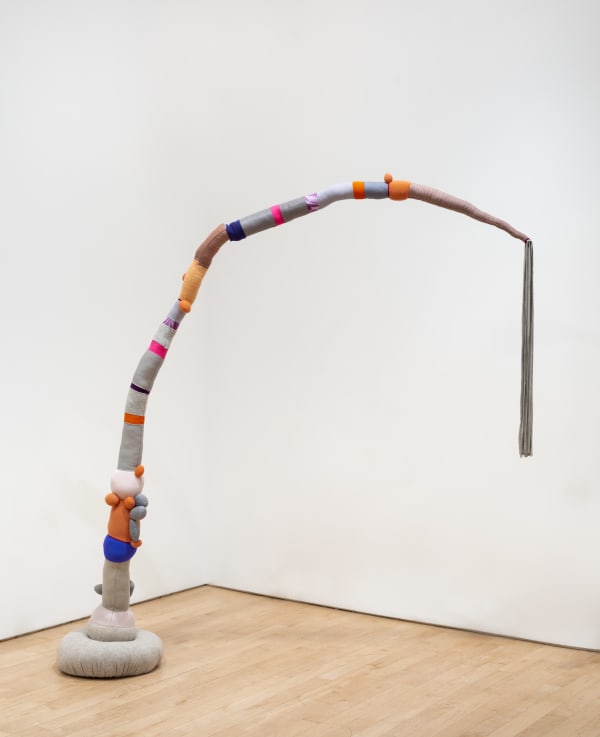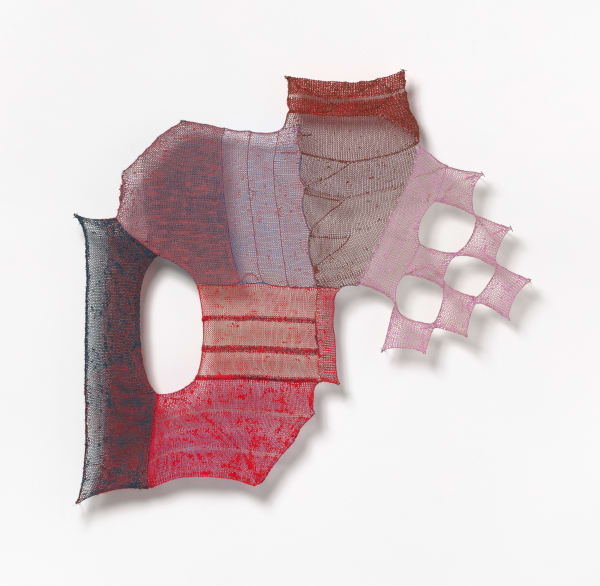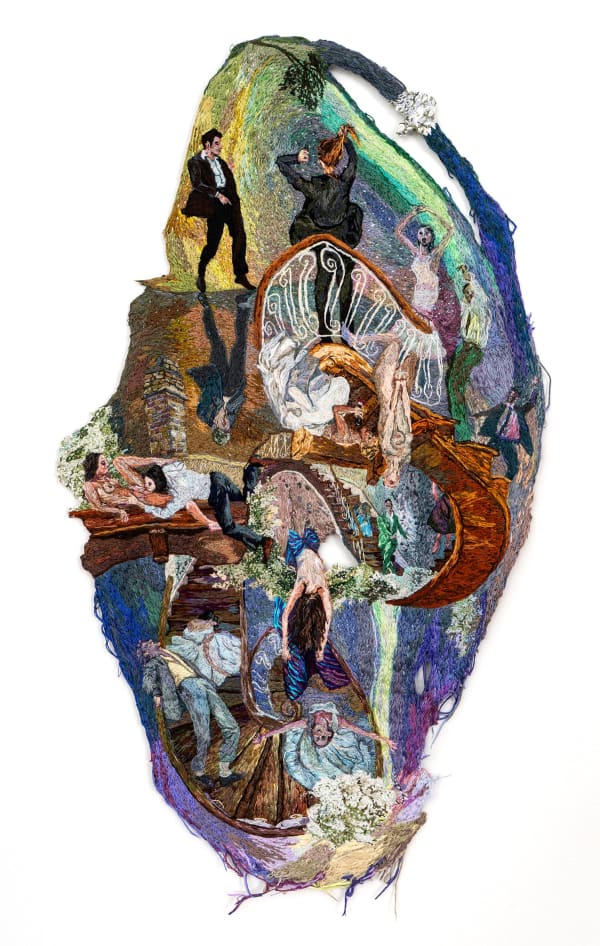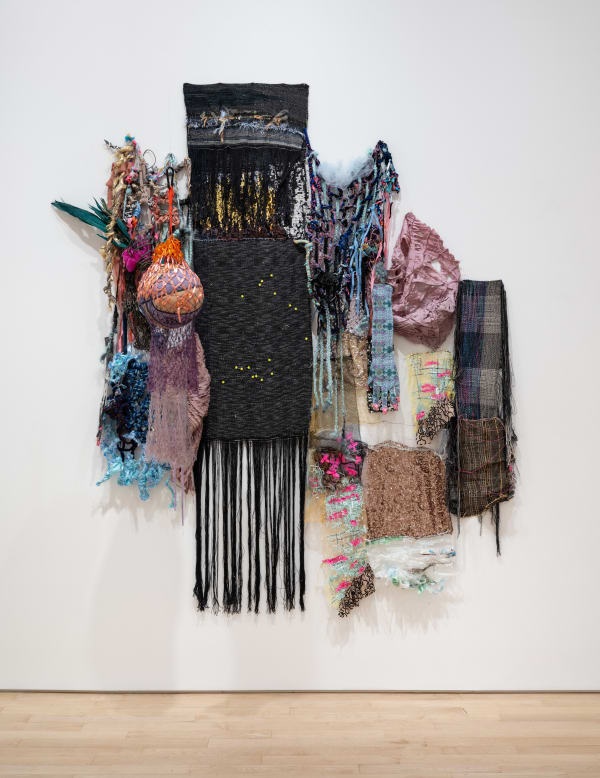Soft Structures : curated by Jen Wroblewski
Jane Lombard Gallery is pleased to present Soft Structures, a group exhibition of new work by ten artists whose primary medium is textile. Working in tapestry weaving, machine knitting, hand sewing, and embroidery, each of the artists in Soft Structures cultivates a deeply personal relationship to material and technique.
Anni Albers famously referred to textile as the “pliable plane,” the raw material of shelter and garment. She grappled with textile as a building material that is simultaneously strong and yielding, and resisted the sissy1 domesticity of craft. Each of the works in Soft Structures is at once flexible and architectural. The technical requirements of making become the aesthetic of the things themselves: the repetition of a stitch; the tension across the bias of a vintage knit, the transparency of a loose weave or a woven plastic. The artists in Soft Structures are centered as engineers and architects; utilizing hard logic and technical maneuvers to build soft objects. In this context, the textile becomes more than a conveyor of color, memory or meaning. With haptic fluency and keen knowledge of technique and tradition, these artists work in dialogue with the textile systems themselves and, in doing so, give us a dignified lens through which to understand them.
Queens-based Korean artist Woomin Kim’s work addresses structures that are micro — nail art, sewing needles — and macro — migration, immigration, labor, consumption. The commercial, aesthetic, and political aspects of nail art converge in Kim’s rambunctious soft sculpture of fingertips and nail art, Sontop II.
Brooklyn textile artist Elodie Blanchard allows the properties of disparate textiles to dictate the shapes of her objects. Drawing inspiration from her studio’s proximity to Greenwood cemetery, Blanchard’s Urns riff on vessel form and function; they are structurally sound, but riotously bulbous and idiosyncratic. To make her Trees, Blanchard combines meaningful textiles — old clothing and domestic textiles associated with specific people in her life.Kentucky-based artist and textile-scholar Crystal Gregory combines weaving and cement. Her objects embody questions of pliability, strength, and permanence. In these works, it is the hand-woven textile that gives the object strength, a foil for the unexpected fragility of the quick-to-crumble cement.
Melissa Dadourian feeds thread into a knitting machine and combines the disparate pieces in sewn arrangements that take their shape from the specific and exact flexibility and strength of each individual panel. Suspended from T-pins an inch from the wall, the works straddle the space between garment, body, sail, and structure. Dadourian has also made a site-specific, large-scale work for the show that combines textiles, both found and made, into an arrangement that feels immersive and suspended in a moment of poetic cohesion. Melissa’s studio is in the Hudson Valley and she splits her time between there and Brooklyn.
Oklahoma-based installation artist Rachel B. Hayes uses fabrics and textile-based processes to create large-scale work. She is interested in inserting color and form into built and natural environments. For Soft Structures, Hayes has created a new piece titled In Tempo and in Temper (from an EB White Essay on the character of New York City.) This diaphanous gridded textile, made from silk and acetate, engages the exterior light of White Street to cast color across the gallery foyer.
Hanna Washburn combines found and vintage textiles, bits of vintage furniture, and hand-built ceramics to create rambunctious forms that occupy an imaginative space between abstraction and figuration. In this practice, she is able to reconsider the domestic modesty of her Massachusetts upbringing and reimagine domestic objects as unruly, colorful, and unexpected. Hanna lives and works in the Hudson Valley.
Zipporah Camille Thompson is a ceramist, weaver, sculptor, and activist based in Atlanta, GA and New York City. A native Carolinian, Thompson draws inspiration from the haunted landscapes of the American South. Through neon hues and iridescent materials, she channels healing energy and protective magic—not only for the fluid elemental bodies she depicts, but also for the bodies of Black and Indigenous women. With woven warp and weft, knotted net-works of interlaced ribbon, and light and shadow, Thompson highlights chaos and transformation, chance, and magic.
Brooklyn-based artist Sophia Narrett creates narrative tableaux in embroidered silk on unexpectedly-shaped substrates. The slow and steady process of embroidery allows Narrett space and time to explore fraught complexities of contemporary womanhood. Her 2023 work, At the Same Time, is a cinematic Bildungsroman, a dramatic and erotic tale told in stitched silk.
Weaving and painting combine to create unexpected new color fields in the work of Ohio artist Jen P. Harris. In their works, analog mark-making, digital vocabularies, and handcraft come together to form queer pictorial spaces that adhere to neither the rules of the virtual nor the physical, offering another lens through which to see.
Finally, Brooklyn-based artist Sarah Zapata’s studio practice is driven by the covalent energies of feminist theory, her Peruvian heritage, and Christian upbringing. Zapata works in multiple textile techniques, including weaving, hand sewing, and rug making, simultaneously embodying traditions of making while subverting levers of control associated with domestic labor. She engages abstraction with shrewd and unexpected decision-making.
About the curator
Independent curator Jen Wroblewski is interested in hand and processes of making. She often finds herself responding viscerally to art objects that resonate with material fluency. From 2018 to 2024, she owned and operated Gold Montclair, a small but mighty contemporary program in Montclair NJ. The gallery mounted 46 exhibitions by 63 artists, 53 of whom were women. Prior to opening Gold Montclair, she curated large group exhibitions addressing mark-making as shamanic behavior (Righteous Perpetrators, 2013) and platforming the additive impacts of parenthood on exhibiting artists (Mother/mother, 2009). Recently she co-curated an exhibition of new quilts by contemporary artists at the Hunterdon Museum of Art (with Mary Birmingham). Wroblewski teaches professional practice and drawing courses at Montclair State University and NJIT’s Hilliard College of Architecture and Design.
____________
1“To work with threads seemed sissy to me. I wanted something to be conquered.” Albers, Anni, “Material as Metaphor,” College Art Association, New York, NY, Conference Presentation, February 25, 1982.
-
 Elodie Blanchard, Urn Big City, 2025
Elodie Blanchard, Urn Big City, 2025 -
 Elodie Blanchard, Urn I Love You, 2025
Elodie Blanchard, Urn I Love You, 2025 -
 Elodie Blanchard, Urn VI, 2024
Elodie Blanchard, Urn VI, 2024 -
 Elodie Blanchard, Xander, 2023
Elodie Blanchard, Xander, 2023 -
 Elodie Blanchard, Pierre, 2019
Elodie Blanchard, Pierre, 2019 -
 Elodie Blanchard, Dave, 2021
Elodie Blanchard, Dave, 2021 -
 Elodie Blanchard, Brad, 2021
Elodie Blanchard, Brad, 2021 -
 Elodie Blanchard, Raphael, 2021-2024
Elodie Blanchard, Raphael, 2021-2024 -
 Melissa Dadourian, Cries and Whispers, 2025
Melissa Dadourian, Cries and Whispers, 2025 -
 Melissa Dadourian, Tilted Grid, 2024
Melissa Dadourian, Tilted Grid, 2024 -
 Crystal Gregory, Shapes of Stillness and Force, 2020
Crystal Gregory, Shapes of Stillness and Force, 2020 -
 Crystal Gregory, Articulations of Space, 2019
Crystal Gregory, Articulations of Space, 2019 -
 Jen P. Harris, Headlong, 2024
Jen P. Harris, Headlong, 2024 -
 Jen P. Harris, Orange Auger, 2024
Jen P. Harris, Orange Auger, 2024 -
 Rachel B. Hayes, In Tempo and in Temper, 2025
Rachel B. Hayes, In Tempo and in Temper, 2025 -
 Woomin Kim, Chen's Room , 2024
Woomin Kim, Chen's Room , 2024 -
 Woomin Kim, Sontop II, 2024
Woomin Kim, Sontop II, 2024 -
 Sophia Narrett, At the Same Time, 2023
Sophia Narrett, At the Same Time, 2023 -
 Zipporah Camille Thompson, Déjà vu, 2025
Zipporah Camille Thompson, Déjà vu, 2025 -
 Hanna Washburn, Keep it Together, 2025
Hanna Washburn, Keep it Together, 2025 -
 Hanna Washburn, Leggy, 2025
Hanna Washburn, Leggy, 2025 -
 Sarah Zapata, Shadow due to change (gargoyle 51 & 54), 2021
Sarah Zapata, Shadow due to change (gargoyle 51 & 54), 2021

























